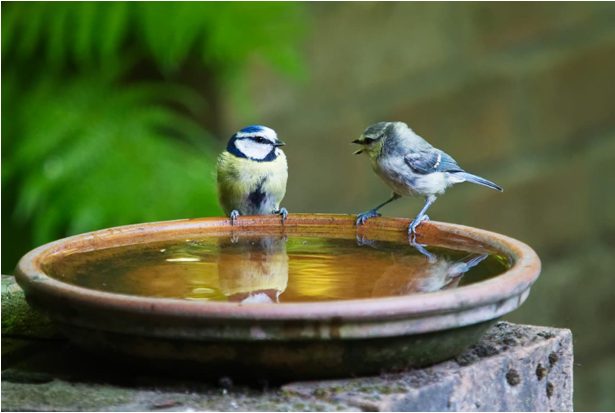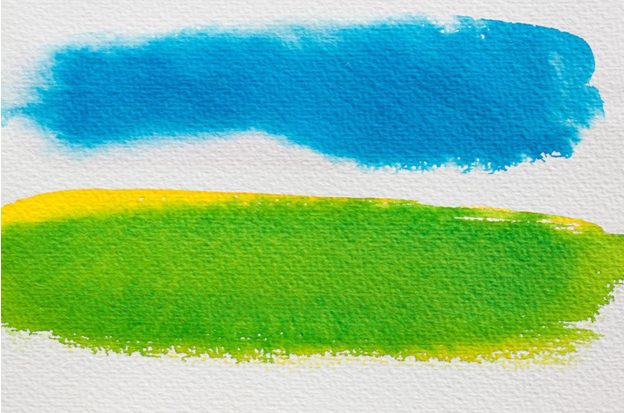There are some color combinations that everyone knows and could guess what the result would be. Most of us know that black and white makes grey, for example.
Some are less obvious, and the answer to what color does blue and green make is not all that obvious.
Once you know the answer, however, you will see that there are many variations and uses for this combination.
So let’s cover how you can mix and match these colors and find out some of the many ways you can use them to create some stunning colors for any artwork you create!
How you can mix blue and green?
The question we are trying to ask in this guide is simple: just how can we use blue and green together?
We would love to give a short answer to that, but the fact is that it’s more complicated than that.
First, let’s look at a few of the ways you can practically mix blue and green. First would be by mixing them together using various art tools and mediums.
One of the best mediums to use would be paints when mixing colors. If you’re newer to painting, then watercolors or acrylics would be great ones to start with as they are easy to use, dry fast and don’t stain as easily.
If you’re more advanced, then you may wish to try out some oil painting. It’s worth remembering that this medium is costly and needs a lot of equipment.
Whichever medium you use, you are then ready to mix paints together. When mixing blue and green, you can play around with different shades of these colors to get the tone you’re after.
We will also cover how additional colors can be incorporated to further customize. When trying out color combinations, we would highly recommend using a spare piece of material that you can paint and experiment on.
When you have figured out how to achieve your chosen color, you can then recreate the effect on your canvas or page.
Mixing paints is just one way to use blue and green together, as you can also use them next to each other. This is another thing we will cover in more detail as we proceed into the guide.
The subject you’re painting will also make a big difference when choosing your colors and trying out different combinations.
Art is at least partially about being observant and being willing to put in the work to experiment.
Now that we have covered a few ways you can mix blue and green, we will go into more detail on some practical ways you can do that along with some tips for design and color theories, so let’s proceed!
Are blue and green a good combination to mix together?
So, now you may be wondering whether blue and green are even a good combination to begin with. Depending on what you’re trying to create, it absolutely can be!
As we mentioned earlier, some color combinations are very well known to people with even very basic knowledge of art and colors. Black and white equals grey, red and blue equals purple.
But what color does blue and green make? There can be many answers to that question, but more often than not you will get a turquoise or cyan shade.
This can depend rather heavily on many factors such as the amount of one color you use as opposed to the other and how dark each shade may be.
Don’t worry, as we will definitely go into more detail on that shortly. Mixing it can result in a lovely combination, but what about using blue and green alongside one another?
When it comes to colors, you generally have warm and cool colors. Blue and green would both be examples of cool colors.
This should be easy to remember, as you merely need to think of the colors of water and blue and green will probably come to mind.
Because they are both colder shades, that means that they blend nicely with one another.
Contrasts between warm and cool colors can also be great, but having ones that are complimentary can also work in different ways.
So now that we know the combination is a good idea in some contexts, you may be wondering how and what you could use these colors for. As always, this certainly depends on the kinds of results you want.
Before you can decide on that, you may want to have some kind of idea of the results you can expect when mixing these colors.
Luckily, that is exactly what we will be covering in the next step of this guide!
What results you can expect
We’ve established that blue and green will create a cyan or turquoise shade more often than not, but mixing colors is never an exact thing.
Even if you mix black and white, the amount you use of each color could make the grey darker or lighter.
We would love to be able to tell you exactly what will happen, but some of that will come down to experimenting.
One of the biggest factors is the different shades you pick to mix together. Not only that, but also the other colors you mix in to achieve the colors you’re looking for.
This is something we will cover in much greater detail later on. Cyan and turquoise are really pleasing colors to the eye, even though they are not as well known necessarily.
Most of us will have heard of turquoise, but may not be able to pick it out from a color lineup unless you have color training. The same is true for cyan and any variations therein.
These two colors are also far from being the only possibilities for mixing blue and green. The different kinds of blue and green that you use could result in something that leans more into the blue side than the green or vice versa,
This is where experimenting comes in, and you will want to do this experimentation on a separate surface. This can be anything you have lying around, as long as it has a relatively clean surface.
You would also want to make sure the color of the object is not too dark if possible. The best thing to use would be a sturdy piece of cardboard or a spare piece of canvas.
When experimenting, try to pay attention to the colors and amount of paint being used. That way, if you strike gold and find the color you are looking for, you will be able to recreate it on the actual artwork.
Now that we have a better idea of the results we can expect, let’s look at some of the uses and practical aspects of mixing these two colors together!
Best uses for blue and green mixes
You know some of the results that can happen as a result of mixing blue and green now and maybe you’ve even done some experimenting. But now the question is what can you do with these pretty colors?
The answer to that is simply: whatever you need it to do! That is an oversimplification of the answer, but it really does depend on the purpose you have in mind for these colors.
As we mentioned in a previous step, blue and green are both cooler colors on the color spectrum. If you’re wanting to keep things realistic, you probably won’t want to use the blue and green mix for fire or a scorching desert.
Instead, more often than not you will probably be working with colder subject matter. For one example, you might be painting the ocean.
This would be a fantastic example of a great use for the blue and green mixture we have been experimenting with. The ocean is usually a shade of blue or green, and this can vary depending on different factors.
So if you’re painting the sea, first try and identify the key colors of the water you’re going to paint. Taking a photo is a great way to do this if you’re actually at the beach.
Then, try your best to mix these colors and blend them with the colors around them. These colors could also be used for the sky or maybe even something like an icy glacier.
That is just a very small selection of colder subject matter these colors could be used for.
You might have many other uses for this color combination, but just remember that more often than not you will probably be using them with something that looks colder or more aquatic.
That being said, you definitely shouldn’t limit yourself to using this color combination for just that kind of purpose!
Colors can turn up in the most unusual of places, so you shouldn’t feel shy about using the blue and green combination in any ways that you like.
Finally, let’s see how to mix these colors to achieve the shades that you are after.

Lighter and darker blue and green mixes
At this point in this guide, we have answered the question of what color does blue and green make along with covering a few ways you could use the resulting colors.
Now, we will cover some of the practical ways that you can achieve the color you are aiming for. For an example, we will pick something with very flat colors that you may want to paint.
For argument’s sake, let’s say you’re painting a turquoise bucket in flat lighting. Look closely at the bucket and try to determine if the color is more on the blue side or the green.
Then, see if the color is dark or maybe a bit lighter. Once you have examined the colors, that is where experimentation comes in, as we will aim to recreate the colors on a flat surface.
Try to start off with the most neutral shades of blue and green that you can. Mix them together and see how it looks.
At this stage, you need not overly concern yourself with how accurate to the bucket (or whatever you’re painting) it is.
If it’s not quite blue enough, try to add a few spots of blue paint. This is something that you will want to try and be careful with.
Remember: you can always add more colors but you can’t remove any from a mixture. Adding more blue and green is just one way that you can alter the shades.
For instance, the bucket may have a subtle yellow hue to it. You could add some yellows to the mix to do this.
Adding black to make it darker and white to make it lighter is always an option, but other colors can help with achieving the more subtle undertones of the colors.
Remember to try out lots of different combinations, as you never know what may result from your experiments!
Sometimes colors you would not expect could be the perfect thing to tip your mixture to where it needs to be.
IN SUMMARY
This guide was all about answering the question of what color does blue and green make?
Now you know that the answer isn’t as simple as it may have seemed, but you also know that there are many uses for this combination.
Now that you have the basics, it’s up to you to take over and see what you can do with it. You can get some truly stunning results from this color combination, and there are no limits to the variations.
Just remember to experiment and incorporate colors that you may not have thought of initially. That way you will achieve any colors you could possibly want!



